Multidimensional and Comprehensive Liquid Chromatography
LCGC North America
Ron Majors discusses advances in multidimensional chromatography and comprehensive multidimensional chromatography.
Multidimensional-chromatography has been practiced for many years, both in off-line and on-line modes. Basically, the experiment involves transferring a fraction or fractions from one chromatographic medium (usually a column) to a secondary (or additional) chromatographic medium (column or columns) for further separation. The technique can be used for further resolution of complex mixtures that cannot be separated entirely on a single medium, for sample cleanup by removing matrix or interfering compounds, for increased sample throughput, and for trace enrichment of minor compounds of interest. The most popular version of multidimensional chromatography is two-dimensional (2-D) chromatography. Table I provides examples of popular combined modes that have been used. In a recent special issue of LCGC Europe, several of these approaches were reviewed in detail (8,9). In the column mode, 2-D chromatography also has been referred to as column switching, multiphase chromatography, coupled column chromatography, boxcar chromatography, and sequential analysis.

Ronald E. Majors
In conventional 2-D chromatography, usually one or only a small number of compounds are of interest. One example would be the high performance liquid chromatography (HPLC) separation and determination of a drug in a biological fluid such as urine. The matrix (for example, proteins, uric acids, and so forth) is of no interest yet may interfere with the analysis and identification of the drug compound in a one-dimensional (1-D) experiment. Other drug metabolites and small molecular weight compounds might also be of little or no interest. By directing a fraction containing the drug peak plus any possible overlapping contaminants from the primary column to a secondary column, the drug can be measured cleanly provided no other components in the fraction happen to elute at the same time on column 2. A simplified schematic of a coupling experiment, a size-exclusion column with an affinity separation column, is depicted in Figure 1.
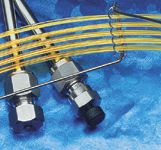
Column Watch
When the demand requires the complete characterization of complex mixtures, then the term comprehensive chromatography is used. The late Prof. Calvin Giddings of the University of Utah, Salt Lake City, coined the term comprehensive multidimensional separation (10). Unlike multidimensional chromatography, in comprehensive chromatographic systems, every fraction from the primary column is subjected to the second dimension. Normally, fractions are diverted from the primary column (10) to the secondary column (20) at defined time intervals.
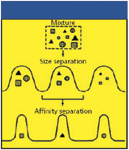
Figure 1: Simplified schematic of 2-D multidimensional chromatography LC separation. The first and second dimension separation modes were size-exclusion and affinity chromatography, respectively.
Proteomics is an area in which extremely complex samples are encountered. All proteins within a cell may be in need of characterization to determine how they are affected in disease states. Because there are potentially tens of thousands of proteins or more, a 1-D separation is inadequate to characterize this complex sample. However, if the proteins (or tryptic peptides) are broken into smaller fractions, which in turn are broken into even smaller fractions by a second (or sometimes even a third) separation dimension, and if they are coupled to a powerful detection measurement technique such as mass spectrometry (MS) (which is really an added dimension), then it is conceivable that individual proteins (or peptides) could be identified at these trace levels. Then, perhaps, the biochemists can measure those individual proteins that can lead to new drugs or other treatments that could block or modify their behavior.
Comprehensive 2-D gas chromatography (GC) (abbreviated GC X GC) is a mature technique with commercial products already on the market. The technique has tremendous separation power, uses simple robust hardware, and has similar analysis times to temperature-programmed high-resolution capillary chromatography. On the other hand, comprehensive 2-D LC (LC X LC) is still in its infancy and is more complex to perform. However, it is driven by user needs, especially in proteomics, and the topic is getting more attention.
The purpose of this month's installment of "Column Watch" is to discuss multidimensional chromatography and comprehensive 2-D chromatography. I will briefly discuss GC X GC, but because much has been written on this approach (3,11), I will focus mainly on LC X LC. I will confine my discussion to the use of 2-D techniques in GC and HPLC. It is obvious that one can extend the experiment to "n" dimensions, but for the most part, many of them are difficult to put into practice. I will also summarize several papers presented on multidimensional chromatography and comprehensive multidimensional HPLC from the recent HPLC 2005 Symposium in Stockholm, summarized in last month's "Column Watch" (12).
Background in Multidimensional Chromatographic Separations
By the combination of multiple chromatographic steps, there is one great advantage: an increase in peak capacity. Peak capacity is, simply stated, the maximum number of peaks that can be resolved in a given timeframe. The more peaks that a combination of techniques can handle, the more complex the samples that can be resolved. When a sample is separated using two dissimilar columns, the maximum peak capacity Φmax will be the product of the individual column's peak capacity Φn (as depicted in Equation 1).

For example, if each separation mode generates peak capacities of 100 and 200, respectively, the theoretical peak capacity of the 2-D experiment will be 20,000, a huge gain in separation space. To achieve this gain, however, the two techniques should be totally orthogonal, that is, based upon completely different principles. For example, in HPLC, if the primary separation column were based upon chirality while the second separation column separated on the basis of hydrophobicity, the individual peak capacity of the combined system would be their multiplicand.
There are many practicalities to be realized when coupling two different chromatographic techniques. In a plenary lecture during the opening session at HPLC 2005, Peter Schoenmakers of the University of Amsterdam, The Netherlands, a member of the Permanent Scientific Committee,discussed the state-of-the-art in multidimensional chromatography and LC X LC comprehensive 2-D separations (13). He detailed some of the factors that govern multidimensional techniques. The most important factors are:
- peak dispersion
- relative speeds, and
- mode compatibility.
Let's examine these factors. As the sample components move down the primary separation column, they become diluted, influencing the injection dispersion of the second dimension. Ideally, their bandwidth should be very small so that they start out as narrow band on column two. If not, the sensitivity and resolution may be compromised. In many cases, an intermediate "refocusing" step might be required. In multidimensional GC, a cold trap might be used; in HPLC, a trapping column could be employed to minimize this band dispersion. Another approach might be to use a narrow bore or capillary column for the first dimension and a wider bore column for the second dimension.
Obviously, if the speed of the first dimension is faster than the speed of the second dimension, something must be done to halt or slow up the primary separation that will affect the overall time. An alternative approach could be to speed up the separation in the second dimension by using a shorter column, faster gradient (LC), faster temperature program (GC), and higher flow rate. Schoenmakers (13) pointed out how Poppe plots (14) can be used to predict the optimum resolution at reasonable separation times using currently available pressures. Combinations of isocratic and gradient elution analyses for the two dimensions might also help to alleviate the speed dilemma.
The compatibility issue is important for the practical coupling of the techniques outlined in Table I. An example of the incompatibility of the two orthogonal techniques in HPLC would be the application of normal-phase chromatography using nonpolar solvent such as hexane as the first dimension. Solvent compatibility difficulties will be encountered if the second dimension is reversed-phase chromatography which uses a polar solvent such as water. In GC, if a packed column is used for the first dimension and a capillary column is used for the second dimension, the sample capacities of the two columns may not be mutually compatible. In coupling LC with GC, the HPLC mobile phase solvent can be detrimental to the GC stationary phase, especially if a large volume is injected.

Table I: 2-D chromatographic techniques
Off-Line Multidimensional Chromatography
Off-line 2-D techniques are performed every day in a normal laboratory operation. Something as simple as a solid-phase extraction (SPE) sample cleanup using a packed cartridge followed by a GC separation is really an off-line 2-D experiment. Because of the ease of collecting and handling liquids, off-line LC–LC and LC–GC techniques are popular. Although less convenient, off-line 2-D GC can be performed by cold trapping the effluent gas stream from a nondestructive detector such as thermal conductivity at the appropriate retention time for the analyte of interest. An alternative method would be to cold trap the analyte from a GC instrument equipped with a postcolumn, predestructive detector (e.g., flame ionization detector) splitter. Although conceivably comprehensive LC X LC and GC X GC could be performed off-line, the handling, concentration, and transfer of multiple fractions for subsequent reinjection could pose some practical problems. Table II lists the advantages and disadvantages of off-line LC techniques.

Table II: Off-line 2-D LC techniques
On-Line Multidimensional Chromatography
From a convenience and automation viewpoint, the on-line coupling of two (or more) chromatographic techniques is preferred. Table III provides some advantages and disadvantages of on-line multidimensional chromatography.

Table III: On-line MDC
On-line 2-D GC (designated GC–GC): The coupling of GC columns via multiport switching valves has been used for many years. However, the metal valves tended to have catalytic activity, unswept volumes, and cold-trapping effects and thus gave lower efficiency and undesirable band broadening (2). Valveless Dean's switching was introduced (15), but the technique was never well accepted until 30 years later with the advent of modern electronic pneumatic control that can be integrated as part of the GC method. Now GC–GC is as convenient and routine as single-column GC. The technique has many variations, including: heartcutting to improve separation in selected regions; backflushing to remove unwanted higher mass components; and packed-to-capillary switching to maximize solute sensitivity. For those interested in the history and varied applications of GC–GC as well as GC X GC, an excellent two-part review on these subjects was published by Bertsch (16,17).
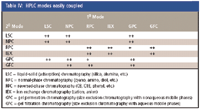
Table IV: HPLC modes easily coupled
On-line Multidimensional LC (LC–LC): In HPLC, the great potential of the on-line technique lies not only in the selection of different modes for the first and second dimensions but also in the ability to use different mobile phases–additives to provide the needed separation selectivity and adjustment of capacity factors. Even more important than off-line LC–LC, a prime requisite is that the mobile phases must have some degree of compatibility. Table IV suggests the different LC modes that can be conveniently coupled based upon the most commonly used mobile phases. Obviously, normal-phase techniques using nonpolar solvents such as hexane or diethyl ether are difficult to combine with modes using predominantly aqueous mobile phases. Thus, Table IV serves only as a guideline because conditions could always be developed to achieve miscibility (for example, addition of a third solvent, miscible with solvent 1 and solvent 2).
The practical application of on-line LC–LC dates back to the early days of HPLC (18–20) when reliable high-pressure multiport valves first became available. In LC–LC, six- and 10-port high-pressure valves with one or two sample loops are used to interface the two separate chromatographic systems. Depending upon the requirements of the experiment, a number of valving configurations can be plumbed to switch flows to employ various techniques such as heartcutting or backflushing. The technique used most often in multidimensional LC is heartcutting, in which all or a portion of the analyte of interest plus coeluted compounds from the primary column are selectively diverted to the secondary column. For example, Figure 2 illustrates an multidimensional chromatography system used to couple a high-pressure size-exclusion chromatography (SEC) column with a reversed-phase chromatography column for heartcutting. In this approach, the effluent from the primary SEC column is passed continuously through one sample loop of a 10-port valve to waste. At the appropriate time, when the desired component(s) of the sample enters the loop, its contents are injected onto the second column. The volume injected is governed by the size of the sample loop volume that is fixed. Another plumbing configuration could allow the effluent from the first dimension to be directed to waste while the second dimension experiment is taking place. In the configuration shown in Figure 2, two chromatographs were employed: a single-pump isocratic system for the SEC column and a dual-pump gradient system for the reversed-phase column. This setup allowed the flow on the primary column to be stopped and additional components on the SEC column handled at a later time. Because diffusion coefficients in HPLC mobile phases are rather small, the band dispersion resulting from stopping the flow for a short period of time is rather minimal. Once the systems are isolated, the second chromatograph then could perform the reversed-phase separation. The advantage of the heartcutting technique is that only the area of interest in the initial separation could be handled, allowing good selectivity. The disadvantage is that, because only a portion of the sample is introduced into the secondary column, sensitivity is reduced.

Figure 2: Schematic of an on-line multidimensional LCâLC system. The first and second dimension columns were high performance size exclusion and reversed-phase chromatography columns, respectively.
Alternatively, the effluent from the SEC column could be directed to the secondary reversed-phase column and all of the initial peak captured but at the expense of decreased sample dispersion on the reversed-phase column — unless some refocusing is done. If the initial column was an SEC column using tetrahydrofuran as the mobile phase, a relatively strong solvent in reversed-phase chromatography, then it might be difficult to divert a large volume onto the reversed-phase column. A large injection volume of such a strong solvent would cause partial migration of injected fractions down the reversed-phase column causing band dispersion thereby limited resolution. On the other hand, if the SEC column was used with an aqueous mobile phase, a large volume could be diverted to the reversed-phase column and the analyte(s) refocused easily because water is a weak solvent in this mode. In this case, something as simple as a three-way diverter valve could be used as the interface between the two chromatographs.
Selected HPLC 2005 Applications of LC–LC
One of the main applications that stood out in HPLC 2005 was the increased use of multidimensional chromatography, not only for proteomics research but for other applications as well. For proteomics, a typical approach reported was to use a narrow-bore cation exchange column (first dimension) to concentrate and perform a rough separation of peptides from a tryptic digest. This step is followed by a desalting step and/or a reversed-phase (second dimension) separation of fractions on a capillary or nanocolumn eluted by a continuous trifluoroacetic acid-acetonitrile gradient. MS was used for detection and identification of separated peptides. One example of this approach in a off-line mode was demonstrated in the presentation of Jenny Samskog and colleagues (GE Healthcare, Uppsala, Sweden) (21). She studied phosphopeptides in brain tissue that are present at the femtomole level. A microbore strong cation exchange column with a 2.1-mm inner diameter with a salt gradient was used for the first dimension. Fractions were collected off-line and reinjected into a trap column where they were desalted. Finally, nanoliquid chromatography using a 75-μm i.d. reversed-phase LC column was used for the final separation step. To improve throughput, a dual column setup was used so that while one column set was performing the analysis, the second column set could be regenerated. Using MS3, phosphopeptides were identified, triggered by their neutral loss of phosphoric acid.
In another HPLC 2005 presentation, David Lubman and colleagues from University of Michigan, Ann Arbor, Michigan (22) used a different and novel 2-D liquid mass mapping technique to find protein biomarkers in tumor cells from ovarian cancer patients. Their group has developed a 2-D liquid separation of intact proteins based upon pI using chromatofocusing in the first dimension and by hydrophobicity using nonporous reversed-phase HPLC in the second dimension. The eluent of the HPLC can be directed into an electrospray-time-of-flight (TOF) MS for analysis of the intact molecular weight of the proteins to produce a mass map of the protein content of the cell. They were able to use this method to study over 25 tumor samples with high reproducibility in analysis based upon pI and MW value to allow comparisons between samples for biomarker discovery. This method can be used to profile tumor protein expression and search for markers specific to subtypes of cancer.
One ever-popular application of column switching is the determination of drugs in biological fluids. If a biological fluid such as blood plasma is directly injected onto a reversed-phase column, hydrophobic proteins and other plasma components can adsorb irreversibly on the column, changing its characteristics and eventually causing a rise in pressure. By choice of a restricted access medium (RAM), columns in the first dimension, and a C18 reversed-phase column in the second dimension, plasma can be injected directly, without incident (23). RAM packings are designed to exclude proteins and other biomolecules yet allow small molecules such as drugs to diffuse into the pores and be retained by hydrophobic interactions. The plasma and other unwanted excipients can be diverted via a switching valves to waste before the drugs are eluted from the RAM column. The analytes, epirubicin and its metabolites, were diverted to the reversed-phase column and separated using isocratic elution. Figure 3a shows the elution profile of a plasma sample from a LiChrospher RP-4 alkyl diol silica (ADS) RAM column (Merck, Darmstadt, Germany) using water as an eluent. Within 5 min, the entire protein matrix was eluted to waste but to play it safe, a time period of 7 min was used before a switching valve was diverted to the second dimension column, a LiChrospher 60 RP Select B (250 mm X 4.6 mm). Figure 3b shows the separation of epirubicin and its metabolites after prefractionation on four different RAM materials. Each RAM gave slightly different recoveries of the analytes and the ADS column gave the best overall performance.
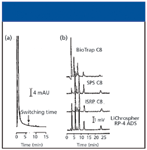
Figure 3: Use of a coupled-column RAMâÂÂreversed-phase chromatography system for the analysis of drugs in plasma (23). (a) Elution profile of a 100-μL plasma sample. First dimension column: LiChrospher RP-4 alkyl diol silica ADS RAM (Merck, Darmstadt, Germany) using water as an eluent at 0.5 mL/min. Second dimension column: 250 mm X 4.6 mm LiChrospher 60 RP Select B. (b) Separation of epirubicin and its metabolites after prefractionation on four RAM materials. Mobile phase: 70:30 (v/v) acetonitrile (0.1% trichloroacetic acid)âtriethanolamine (pH 2); flow rate: 1.0 mL/min; detection: fluorescence (excitation wavelength: 445 nm, emission wavelength: 560 nm). Peaks: 1 5 epirubicinol, 2 5 epirubicinal aglycone, 3 5 epirubicin, 4 5 epirubicin aglycone, 5 5 7-deoxyepirubicinal aglycone. Compounds were in the 5.6â8.2 ng/mL concentration range.
Other multidimensional chromatography applications at HPLC 2005 were reported. Egidijus Machtejevas and colleagues, Johannes Gutenberg-University, Mainz, Germany; Merck, Darmstadt; and Astra-Zeneca, Molndal, Sweden (24) developed a novel sample cleanup column to study endogenous peptides in biofluids by direct injection. The packing consisted of a RAM with strong cation-exchange functionality. By adjusting the pore size of the packing, size exclusion could be used to determine the molecular weight fractionation range and the selective ion exchange chromatography could be performed within the pores. For added selectivity, Jan Haginaka and H. Sambe of the Mukogawa Women's University, Nishinimiya, Japan (25) developed a combined RAM and molecular imprinted polymer (MIP). MIPs are used for the very selective extraction of target compounds, while RAMs have been used for the direct injection assays of drugs and metabolites in biological fluids. Although MIP template leakage is still a problem, by the use of an isotopologue form of the template molecule and MS detection, the template leakage will not interfere because MS can discriminate between the labeled and unlabeled target compounds. Using bisphenol A as a model compound, trace levels were determined in serum combining column switching and LC–MS.
From a more theoretical side, Pavel Jandera and colleagues from the University of Pardubice, Czech Republic (26) studied structural effects on the separation selectivity and performance optimization in 1-D and 2-D LC systems. The goal of the work was to characterize the degree of orthogonality between the first and the second dimension systems in 2-D LC using the correlation characterizing the similarity of selectivity in the two separation systems, allowing more efficient use of the peak capacity theoretically available in 2-D HPLC. A model was derived for the 2-D system with partially correlated selectivities, allowing to predict the range of the structural units in a 2-D sample (according to the Giddings' notation) that can be resolved in a given time range for the two dimensions for not fully orthogonal systems. The group also investigated the possibility of phase transfer between a reversed-phase system (1-D) and a normal-phase system (2-D). A hydrophilic interaction LC (HILIC) system was proposed for the second dimension in a reversed phase–normal phase LC X LC system. The HILIC system was more resistant to aqueous solvents transferred from the first dimension than classical NP systems with nonaqueous mobile phases. This system was used for comprehensive 2-D separation of ethylene oxide–propylene oxide (co)oligomers.
Comprehensive GC (GC X GC): GC X GC is the most developed of the comprehensive chromatographic techniques by far. Not only has the technique been widely applied to complex mixtures (3,5,16,17) but commercial instrumentation is available. The key to successful application of GC X GC is the ability to trap or thermally modulate at the juncture of columns 1 and 2 (11), as this defines the amount of time provided for the second separation if "wrap around" peaks are to be avoided. Ideally, the first dimension should be relatively slow and the second dimension much faster. In theory, one could stop the flow of the first column but since diffusion coefficients of volatile solutes in a typical GC carrier gas are quite high, some band spreading would be expected. However, the ability of modern instrumentation to rapidly cool (via cryojets) trapping columns and to rapidly heat these same columns has made GC X GC practical to perform routinely. Throughput is an order of magnitude better than 1-D GC and modern data systems provide 2-D outputs that are easy to interpret.
Comprehensive LC (LC X LC): As Schoenmakers pointed out (13), LC X LC has a way to go before it reaches the level of GC X GC. Currently, peak capacity for a typical LC X LC experiment rarely approaches 1000, even with separation times in the 1-h timeframe. Typical proteomics LC X LC + MS experiments still require many hours whether performed off-line or on-line. The number of proteins that have been separated and identified in a typical experiment is a fraction of the tens of thousands that are present in a typical cell extract. Its established competitor, 2-D gel electrophoresis, also requires many hours to accomplish similar tasks, is very labor intensive, lacks reproducibility, and is difficult to quantitate over a wide dynamic range. So, there is a bright future for LC X LC. With the advent of monolithic columns (27,) in conventional and capillary–nanocolumn–chip formats, superficially porous packings (28), and short, fast sub-2-μm columns, the ultrahigh-speed separations of small and large molecules, especially in the second dimension, should improve the situation.
Selected HPLC 2005 Applications of LC X LC
A number of papers presented at HPLC 2005 showed that LC X LC could be put to practical use.
In an oral lecture at HPLC 2005, Tanaka and colleagues of the Kyoto Institute of Technology, Kyoto, Japan reported on their continued work with silica monoliths (29). Their emphasis has now turned to comprehensive 2-D applications of monoliths,in which columns of different dimensions are coupled via a switching valve. Using 2-D contour plots, they looked at the types of monolithic column and mobile phase conditions (isocratic and gradient elution and high flow rates) to maximize the time resolution of multicomponent mixtures. Obviously, when both monolith columns were of the same types such as C18, there were many blank spaces in the contour plots, meaning that the resolution per unit time was not optimal. By using different mobile phase compositions, water-tetrahydrofuran in the first dimension and water–methanol in the second dimension, they achieved a semi-orthogonal separation that gave an increased peak capacity. But, when they switched to a truly orthogonal set of columns using a strong cation exchange microparticulate column (1-D) coupled to a reversed-phase monolith (2-D), the peak capacity was increased dramatically. By the use of these orthogonal columns combined with a gradient run in the first dimension and isocratic elution in the second dimension, they achieved peak capacity of 700. Tanaka then spelled out a set of ideal conditions for the second dimension column.
One of the problems with conventional silica monolith columns (4.6-mm i.d.) is the high solvent usage. These columns are often used at 4–5 mL/min to achieve high-speed separations. Reduction of the column dimensions to capillary sizes (0.25-mm i.d. or smaller) helps to cut down on solvent use but still provides sufficient capacity for the sample sizes encountered. The application of capillary polystyrene–divinylbenzene monoliths in the second dimension was also a popular topic at HPLC 2005.
Sandra and colleagues (7) reported on the use of LC X LC as well as the combination of supercritical fluid chromatography and HPLC (SFC X LC) as applied to complex mixtures of natural products. In the latter technique, the use of supercritical carbon dioxide as the mobile phase for the first dimension offers the advantage of easy transfer and excellent compatibility since the carbon dioxide can be evaporated during the process. They also combined normal phase chromatography (1o) with reversed-phase chromatography (2o) and overcame the solvent compatibility problem by using a 1-mm i.d. normal phase column operating at 50-μL/min coupled to a 4.6-mm reversed-phase column operated at a high flow rate to give a 1-min analysis. The small amount of nonpolar solvent from column 1 could be accommodated by the larger volume of column 2 without detrimental effects.
Y. Zhao and colleagues (30) presented a pharmaceutical application of LC X LC combined with UV and MS detection. They assembled a fully automated multidimensional LC system that could be used for LC–LC (heartcutting) and LC X LC. This initial system was used to ensure that there were no coeluted compounds in their formulations and to characterize impurities. Coupling normal phase chromatography (diol) as the first dimension using 1-mm i.d. columns with a 4.6-mm i.d. C18 monolith column as the second dimension, they were able to analyze a fraction every 60 s. Figure 4a shows the separations achieved on the two columns for a proprietary drug mixture. Note the good orthogonal separations achieved on the two different systems. Selectivity was quite different on the two columns. Finally, Figure 4b provides a colored contour plot resembling a typical 2-D profile resulting from the LC X LC + UV coupling experiment.

Figure 4: (a) Comprehensive 2-D-LC Mode: normal-phase LCâreversed-phase LC-UV-MS. (Top) First dimension normal-phase LC. Column: 250 mm X 1 mm, 5-μm dp Betasil diol (Thermo Electron Corporation, Waltham, Massachusetts; mobile phase: 85:15 hexaneâ1-butanol 1 0.2% ethanolamine, isocratic; fl gradient: 25% B for 3 s, to 50% B in 3 s, to 100% B in 15 s, 100% B for 9 s, back to 25% B in 3 s; flow rate: 5 mL/min (170 bar); 30 °C; sample: pharmaceutical compounds B-mix; response time: 0.1 s. (b) Comprehensive 2-D-LC-UV chromatogram.
An environmental application of LC X LC was reported by Riekkola and colleagues from the University of Helsinki, Finland (31). Aerosol particulates containing carboxylic acids are typically very complex, and it is not possible to separate all of the analytes by traditional chromatographic methods. To solve this problem, these researchers were able to combine cation-exchange chromatography (10) using a narrow-bore column (150 mm X 1.0 mm, 50-μL/min flow rate) with a silica-based monolithic reversed-phase column (100 mm X 4.6 mm, 3.5-mL/min flow rate) (20) using the same mobile phase for each dimension but with a different composition. A modulating device was constructed from a 10-port PC-controlled valve and two 50-μL sampling loops. The modulation time was only 1.0 min. Because of the low flow rate in the first dimension and the rapid flow rate in the second dimension, it was possible to transfer every fraction to completely characterize the organic acid content of the aerosol. The use of UV and time-of-flight TOFMS aided in the identification of the separated acids.
Conclusion
Multidimensional chromatography has long been used for resolving selective components from poorly resolved samples in both off-line and on-line applications. The advent of modern low-volume, high-pressure multiport switching valves conveniently packaged that can be precisely controlled and programmed by computerized instrumentation, on-line multidimensional chromatography should receive more attention as a way to cleanup difficult samples and improve analytical results. Comprehensive multidimensional chromatography should see even more widespread application as more difficult samples that must be fully characterized are encountered. GC X GC has already proved itself in handling difficult volatile samples such as hydrocarbons in petrochemical samples (32). In HPLC, with full characterization, requirement could dictate the use of longer columns with small particles to give enhanced chromatographic resolution but at the expense of increased pressure. However, because the increase in peak capacity will increase only with N1/2 with the longer column, such a system will have a difficult time competing with the significant increase of peak capacity with LC X LC performed at more moderate pressures.
Ronald E. Majors "Column Watch" Editor Ronald E. Majors is business development manager, Consumables and Accessories Business Unit, Agilent Technologies, Wilmington, Delaware, and is a member of LCGC's editorial advisory board. Direct correspondence about this column to "Sample Prep Perspectives," LCGC, Woodbridge Corporate Plaza, 485 Route 1 South, Building F, First Floor, Iselin, NJ 08830, e-mail lcgcedit@lcgcmag.com
References
(1) S. Nyiredy, Recent Applications in Multidimensional Chromatography, December 2003, 52–59.
(2) K. MacNamara, R. Leardi, and A. Hoffmann, LCGC Eur. 16(12), 14–22.
(3) P. J. Marriott, P.D. Morrison, R.A. Shellie, M.S. Dunn, E. Sari, and D. Ryan, Recent Applications in Multidimensional Chromatography, LCGC Eur., December 2003, 23–31.
(4) E. Hogendoorn, P. van Zoonen, and F. Hernández, Recent Applications in Multidimensional Chromatography, LCGC Eur., December 2003, 44–51.
(5) P. Dugo, G. Dugo, and L.Mondello, On-line Coupled LC–GC: Theory and Applications, LCGC Eur., December 2004, 35–43.
(6) B. Tienpont, F. David, A.Stopforth, and P. Sandra, Recent Applications in Multidimensional Chromatography, LCGC Eur., December 2004, 5–13.
(7) I. Francois, A. de Villiers, C. Brunelli, F. David, and P. Sandra, HPLC 2005, Stockholm, Sweden, paper P10:10, June 29, 2005.
(8) Recent Applications in Multidimensional Chromatography, LCGC Eur. 16(12a), 2003.
(9) http://www.lcgceurope.com/lcgceurope/issue/issueDetail.jsp?id=2886.
(10) J.C. Giddings, J. High Resolut. Chromatogr. 10, 319–323 (1987).
(11) J.V. Hinshaw, LCGC 22 (1), 32–40 (2004).
(12) R.E. Majors, LCGC, 23(9) 1016–1023 (2005).
(13) P. Schoenmakers, HPLC 2005, Stockholm, Sweden, paper SuPL:1, June 25, 2005.
(14) H. Poppe, J. Chromatogr., A 778, 3–21 (1997).
(15) D. Deans, Chromatographia 1, 18–22 (1968).
(16) W.J. Bertsch, J. High Resolut. Chromatogr. 22, 647–665 (1999).
(17) W.J. Bertsch, J. High Resolut. Chromatogr. 23, 167–181 (2000).
(18) L.R. Snyder, J. Chromatogr. Sci. 8, 692 (1970).
(19) J.F.K. Huber, R. van der Linden, E. Ecker, and M. Oreans, J. Chromatogr. 83, 267 (1973)
(20) E.L. Johnson, R. Gloor, and R.E. Majors, J. Chromatogr. 149, 571–585 (1978).
(21) J. Samskog, H. Wadensten, and J. Flensburg, HPLC 2005, Stockholm, Sweden, paper TuL7: 1, June 27, 2005.
(22) D.M. Lubman, Y. Zhu, H-Y Kim, Y. Wang, R. Wu, K. Cho, M. Pal, A. Sreekmar, and A. Chinnaiyan, HPLC 2005, Stockholm, Sweden, paper TuL2: 1, June 27, 2005.
(23) A. Rudolphi and K.-S. Boos, LCGC 15(9), 813–823 (1997).
(24) E. Machtejevas, K.K. Unger, D. Lubda, R. Hendriks, and M. Miliotis, HPLC 2005, Stockholm, Sweden, paper TuL7: 1, June 27, 2005.
(25) J. Haginaka and H. Sambe, HPLC 2005, Stockholm, Sweden, paper MoL7: 3, June 26, 2005.
(26) P. Jandera, K Novotna, J. Fischer, M. Halama, and L. Kolarova, HPLC 2005, Stockholm, Sweden, paper TuL1: 2, June 26, 2005.
(27) N. Tanaka, H. Kimura, D. Tokuda, K. Hosoya, T. Ikegami, N. Ishizuka, H. Minakuchi, K. Nakanishi, Y. Shintani, M. Furuno, and K. Cabrera, Anal. Chem.76, 1273–1281 (2004).
(28) R. Ricker, C. Woodward, and R.E. Majors, Am. Lab., July 2004, 25–32.
(29) T. Ikegami, H. Kimura, T. Hara, H. Kobayashi, K. Hosoya, K. Cabrera, and N. Tanaka, HPLC 2005, Stockholm, Sweden, Lecture TuK4, June 27, 2005.
(30) Y. Zhao, A. De Villers, P. Sandra, T. Baumgartner, B. Zhang, and J. Kofman, HPLC 2005, Stockholm, Sweden, paper WeL3:3, June 29, 2005.
(31) R. Edam, J. Blomberg, H. -G. Janssen, and P.J. Schoenmakers, J. Chromatogr., A 2086, 12–20 (2005).
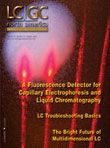
New Study Reviews Chromatography Methods for Flavonoid Analysis
April 21st 2025Flavonoids are widely used metabolites that carry out various functions in different industries, such as food and cosmetics. Detecting, separating, and quantifying them in fruit species can be a complicated process.













